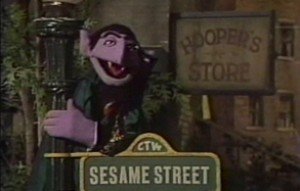Sesame Street Ep #666
The sixth season of Sesame Street debuted on November 4, 1974, with the ominously numbered episode 666 (which is available to watch on the Sesame Street: Old School Volume 2 DVD set). Despite that, as should surprise no one, nothing actually disastrous occurs, however I do wonder whether the hour’s framing device of the Count perching on the famous Sesame Street lamppost and counting all of the lights on Sesame Street going on in the early evening and off later at night was meant to be a sly little nod to it, due to the Count’s vampiric origins.
This is actually a very different way to start a Sesame Street season, which usually opens up on a bright, energetic scene that reintroduces and plunges the audience into its bustling city environment. Instead, here, we return to a much more sedate scene. Maria is reading a book on the fire escape outside of her apartment window, David is sitting at an outside table, spending time with some of the kids on the street, Gordon and Susan are walking home from a presumably long day of work. Everything is basically winding down for the evening, and it’s all so low-key, I almost didn’t notice that Gordon has once again been recast, only this time it’s finally Roscoe Orman, who has remained with the show to this very day. But we don’t get much of him at all in this episode, maybe because they were trying to ease him in as naturally as possible, without calling attention to the change. And returning to the Count’s light-counting, I particularly love how one of the many lights that turns on this early autumn evening is coming from Oscar’s trash can. Apparently even a Grouch needs to be able to see around his place after Daylight Savings Time ends.
Later on, such an episode would have likely stuck to this evening-on-Sesame-Street conceit throughout the entire episode, or at least during each of the street scenes. Unfortunately, however, we’re still not at a point in the show’s history where the street scenes are actually held together with a plot (which continues to surprise me, as I expected them to do so far earlier, even if only to create more material to fill up so many episodes!) and so there is at least one musical number done in full daylight later in the episode, as well as one that does occur at night but in which everyone is at Hooper’s shop, which doesn’t exactly track with the fact that, by the end, everyone will be in the exact same position and doing the exact same thing they were doing at the start of the episode. At the very least, however, there aren’t many street scenes at all in this one. In fact, there might be the fewest of any episode I’ve seen so far, so it seems like they were making some effort to stick as closely to the concept as they could. However, mostly avoiding the issue isn’t necessarily the ideal way to go about doing that!
Overall, other than that, this is a pretty typical early Sesame Street episode, with little coherence or connective tissue between various segments other than some thematic and/or subject overlap between adjacent scenes. We transition from the exterior opening to a song I remember from childhood, “Exit,” in which a 1950s style group (complete with slicked up hair) called Little Chrissy and the Alphabeats explain the word, clarifying that “all you cats who feel kind of stuck in one place” can leave the room they’re in by finding the exit sign. The refrain, “Exit is the way, way out,” makes for a particularly groovy pun, man. Unfortunately for Little Chrissy, however, the entire audience as well as the rest of his band seem to not be enjoying the song very much because they all end up taking his advice, one by one leaving by the exit door situated right behind him. Only by the end does he realize he’s the only one left, and then, as it turns out, he hasn’t been listening to his own lyrics because once he’s done, he wanders back and forth around the room, desperately trying to figure out how to follow the others out of the room!
Then, skipping ahead a bit, we come to a genuinely bizarre cartoon that seems like the product of someone having an LSD nightmare during a viewing of Monty Python and the Holy Grail. It’s basically about a group of kids being chased by an enormous, seemingly mutant rabbit, while fast rock music blares in the background, the Monty Python parallels apparent not only in the form of the carnivorous coney but in the animation style, which looks straight out of Terry Gilliam’s darkest fever dreams. I can’t necessarily say beyond a shadow of a doubt that it’s the weirdest thing I’ve seen on Sesame Street so far, but it’s way up there. And the educational content of the piece? Erm, basically that the 3 kids running for their lives temporarily hide behind 3 trees. Either way, pure nightmare fuel. Hmm, maybe that 666 number is more appropriate than I realized!
Luckily, the next sketch is far less horrific, or rather, not horrific at all. It’s yet another episode of the Guy Smiley game show, Beat the Time! This time around, Grover is the contestant and his goal is to find 5 things that contain milk, which is nifty because it shows the variety of topics the Sesame Street writers utilized even within the same sketches, not just relying on the same subject every time:
Whereas Cookie Monster’s episode taught rhyming, Grover’s teaches a different sort of practical concept, namely ingredients, specifically dairy products, while at the same time, there’s also a more subtle underlying counting lesson going on, and so again we have a sketch that operates on multiple levels, serving various functions at once, one of course being pure entertainment. And like most of Sesame Street‘s great sketches, it also ends on a fun little twist, for after Grover brings ice cream, cheese, and butter on stage, what else can he find in the last 5 seconds of time that also contain milk? Why, 2 cows!


